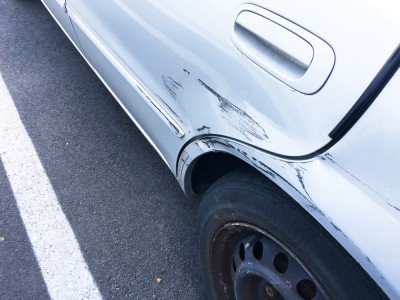How to Fix Your Car's Minor Scratches
 For more serious scratches on your vehicle's exterior, you should always consult a professional, including all of us at CARSTAR Ideal Auto Body Littleton. We often see some serious scratches in Littleton, CO and most of the time they are caused by debris on the road, vandalism or weather-related events.
For more serious scratches on your vehicle's exterior, you should always consult a professional, including all of us at CARSTAR Ideal Auto Body Littleton. We often see some serious scratches in Littleton, CO and most of the time they are caused by debris on the road, vandalism or weather-related events.
But for shallow scratches, you can fix them yourself, by following these simple steps.
First, you’ll need to have the following:
· Dish soap and water
· Three towels or cloths (Use microfiber-based products if possible)
· Masking tape (No duct)
· 2000 grit sandpaper
· Rectangular sponge
· Rubbing compound
· Polishing compound
Step 1: Determine the depth of the scratch
The positive news here is that many scratches are rather easy to remove, but not all of them are always the same. You can’t get rid of an offending scratch or gouge until after you’ve assessed its depth. In order to deal with your scratch correctly, you’ve got to determine the number of layers that it has penetrated through. To figure it out, all you simply need to do is take your fingernail and drag it across the scratch. If you can’t feel it, then it is likely a “clear coat scratch.” This means it is shallow and hasn't gotten past the clear coat. If you do detect an edge along the scratch, then it has penetrated through the clear coat to the basecoat. If that's the case, you should take it to a shop, because at that point it is no longer a DIY project.
Step 2: Cleanse the area completely
Dirt is your enemy, so get rid of it. To clean the scratched area, take some soapy water on a clean towel and wipe around the offending scratch. When you're done cleaning make certain to gently dry everything off before proceeding.
Step 3: Commence wet sanding
Take a sheet of sandpaper and soak it in cold water for a minimum of 20 minutes. Wrap the wet sandpaper around a sponge and then gently sand the scratch, rubbing in the direction of the original scrape. Make sure to sand slowly and carefully, because you don't want to get done to the basecoat.
Step 4: Rinse often to check your work
Excessive sanding can ruin your project rather quickly, so check your work often to make sure you're going in the right direction. Periodically put the abrasive paper down and rinse the scratched area with some clean water. If the original scrape is still there,then it’s time for another sanding session, followed by another rinse. Repeat this process until you can't see the scratch anymore.
Step 5: Step in with the rubbing compound
The sanding process will dull your car’s exterior, but don’t panic, because a good rubbing compound will save the day. Pour a modest amount of the product onto a clean cloth and then evenly rub it over the area you’ve been working on until the surface becomes nice and shiny.
Step 6: A finishing polish
Finishing polish goes a long way so drop a tiny amount on a clean cloth. Use a circular motion and apply it across the same area that you previously sanded and covered with rubbing compound. Once the surface begins to look shiny again, peel off your masking tape and wash it down one last time and you're done!
Sources: DIY News, AOL and Facebook









 For more serious scratches on your vehicle's exterior, you should always consult a professional, including all of us at CARSTAR Ideal Auto Body Littleton. We often see some serious scratches in Littleton, CO and most of the time they are caused by debris on the road, vandalism or weather-related events.
For more serious scratches on your vehicle's exterior, you should always consult a professional, including all of us at CARSTAR Ideal Auto Body Littleton. We often see some serious scratches in Littleton, CO and most of the time they are caused by debris on the road, vandalism or weather-related events.
Social